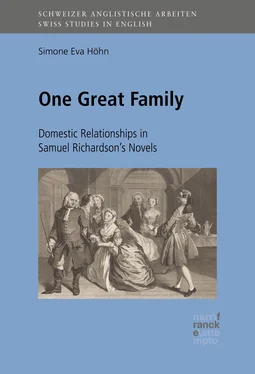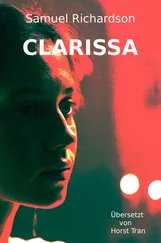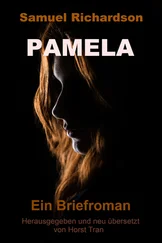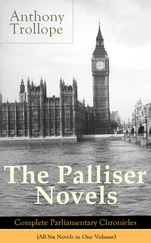The body, then, can figure as an extension of, not just as a contrast to, the mind. Where they are under good regulation, they merge into one. Thus, in one of his letters, Richardson describes the development of love in terms of body and mind: “Bodies may be sundered in Youth, may be torne from each other, and other Bodies may supply the Loss: For the Loves of Youth have more in them of Body , than of Mind, let Lovers fancy what they will. But in Age a Seperation [ sic ] may be called a Seperation of Souls” (Sabor, Correspondence 40; 15 Dec. 1748, to Lady BradshaighBradshaigh, Lady, correspondent of Richardson). While this statement clearly subscribes to a difference in value between body and soul, it describes “body” rather as an inevitability than as an evil, as a human frailty which may turn to good rather than as something which has to be eschewed altogether. Thus, while the love of body must be subordinate to the love of mind – as Mr. B. finally comes to value Pamela’s mind above her beauty –, Richardson’s characters nevertheless express it openly – for example, in the caresses shared between Pamela and Mr. B. even before he marries her.
Body becomes problematic mainly in Clarissa , and there, mainly for the two rakes Lovelace and Belford and for the dying heroine. However, for the latter, her “clinging body” (cf. 1265) seems a nuisance rather than an evil, an obstacle to be overcome as she leaves the material, imperfect world for heaven. For Lovelace and Belford, in contrast, the body is problematic already in this life: for them, it stands in almost binary opposition to the soul. Thus, Lovelace can envisage only Clarissa the frail woman (body) or the unconquerable angel (mind); neither of them, however, can he marry. Similarly, Belford’s admiration of Clarissa culminates in repeated statements that she is too much soul to be married. Indeed, both rakes – the one who will reform and the one who will not – seem to require a saint rather than a woman. John MullanMullan, John has claimed that “Richardson mythologizes femininity—and, like many male writers before and since, he isolates virginity as its essential representation” (67). This is an accurate description of the rakes’ initial attitudes, but it hardly accounts for Clarissa’s courageous confrontation of Lovelace after the rape (noted, for example, in Sarah Fielding’s Remarks on ClarissaFielding, Sarah, correspondent of Richardson 33–4), or for the celebration of bodily pleasures in Pamela and Grandison (cf. DoodyDoody, Margaret Anne, A Natural Passion , and 3.1). Ironically, the rakes’ insistence that Clarissa is an angel rather than a woman signalises their own lack of a well-regulated mind; they need Clarissa to be saintly so that she can connect them to the divine.
Clarissa’s relationship to God is direct and unmediated, although she relies on the guidance and example of admired friends to strengthen her faith. Lovelace, in contrast, “can see heaven only through [Clarissa]” (DoodyDoody, Margaret Anne, A Natural Passion 181). Similarly, Belford relies on “the divine SOCRATES, and the divine CLARISSA” (884) to prove the existence of a rewarding heaven, and envisages her as a saving angel who carries him to heaven (1275).11 This idea complements Lovelace’s dream, where Clarissa, in a scene reminiscent of Catholic images of Mary and of Christ rising from the tomb, is exalted into heaven, while he falls into the abyss (1218; cf. also Doody, A Natural Passion 235–8). Indeed, Lovelace (and his family) builds all his hopes of salvation on Clarissa’s direct agency: she must forgive him as a precondition for God’s forgiveness, she must guide and reward him – and yet all this without any shadow of ‘womanly’ weakness. His continued distrust of female virtue highlights that, as he admires Clarissa more and more, he does so as a saint rather than as a human being.
Clarissa’s religious journey – her steady preparation for death, in which she throws off not only her “clinging” body but even “weans” herself from the people she loves – might seem to confirm the rakes’ belief that body and soul co-exist at best in an uneasy truce. Yet the heroine’s holy death, where she relinquishes everything in this world that has been dear to her, is succeeded by an affirmation of these same worldly concerns. Clarissa’s will, for example, re-affirms all her earlier responsibilities and joys – including duty to her family, friends and servants, but also the disposition of her clothes, jewellery, and musical instruments. The renunciation of the dying, clearly, is not to be imitated by the survivors. Similarly, Clarissa’s almost single-minded preparation for death is contrasted by Anna’s outline of Clarissa’s daily and weekly schedule while living, where “closet-duties” (which seem to include prayers, her toilet, and her correspondence) take up only three hours of each day, albeit the first three. Renunciation of her body, and of the world as a whole, then, is not a general necessity but the result of Lovelace’s efforts to distinguish between body and soul.
This chapter seems to have led us a far way from the system of duty – appropriately, perhaps, because Lovelace’s testing of Clarissa is, likewise, incompatible with it. AllestreeAllestree, Richard assumes that human beings are by their nature fallible, but must strive to be as free from faults as possible; seducing another to sin is one of the gravest crimes. Lovelace, in contrast, sets up temptations to Clarissa in order to prove her in-fallible – or to make her “[his] upon [his] own terms” (886). For most of the novel, moreover, it seems that he can locate true virtue only in some kind of ‘essence’ of the soul. This is why Clarissa’s behaviour, however ‘cold’ and virtuous, cannot convince him of her sincerity. It is as if Allestree’s father-king tried to torment his subjects in order to discover the point at which they will turn from obedience to rebellion – a test which can only end in the ruin of at least one of the parties involved.
Lovelace’s probing of Clarissa’s soul is, of course, doomed in another way as well, since he needs her to desire him even more strongly than he needs her to be virtuous. However, because he has defined desire as the opposite of virtue, he can never accept her as a woman who embodies both.12 Indeed, at one point, Belford warns him that he should not test Clarissa for too long because no woman can hold out against all temptations: “if I preferred a lady as I know thou dost this to all the women in the world, I should dread to make further trial, knowing what we know of the sex, for fear of succeeding” (501). Belford, like Lovelace, is proved wrong in this point. However, his caution is true in another sense. Passion and virtue can coexist in a woman, but only if this possibility is accepted by the men around her. Lovelace, who will not accept the system of duty, thereby produces the need for a binary opposition between body and mind. In contrast, the good men of Grandison (and the reforming Mr. B.) – who acknowledge and celebrate the union of desiring/desirable body and virtuous mind – enable and enjoy its existence.
Конец ознакомительного фрагмента.
Текст предоставлен ООО «ЛитРес».
Прочитайте эту книгу целиком, купив полную легальную версию на ЛитРес.
Безопасно оплатить книгу можно банковской картой Visa, MasterCard, Maestro, со счета мобильного телефона, с платежного терминала, в салоне МТС или Связной, через PayPal, WebMoney, Яндекс.Деньги, QIWI Кошелек, бонусными картами или другим удобным Вам способом.












